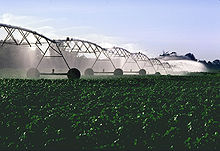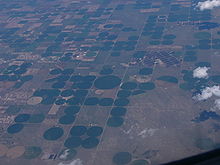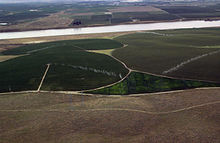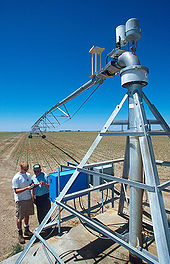- Center pivot irrigation
-
Center-pivot irrigation (sometimes called central pivot irrigation), also called circle irrigation, is a method of crop irrigation in which equipment rotates around a pivot.[1] A circular area centered on the pivot is irrigated, often creating a circular pattern in crops when viewed from above.
Contents
How it works
 Pivot irrigation in progress on a cotton farm.
Pivot irrigation in progress on a cotton farm.
Central pivot irrigation is a form of overhead (sprinkler) irrigation consisting of several segments of pipe (usually galvanized steel or aluminium) joined together and supported by trusses, mounted on wheeled towers with sprinklers positioned along its length. The machine moves in a circular pattern and is fed with water from the pivot point at the center of the circle. The outside set of wheels sets the master pace for the rotation (typically once every three days). The inner sets of wheels are mounted at hubs between two segments and use angle sensors to detect when the bend at the joint exceeds a certain threshold, and thus, the wheels should be rotated to keep the segments aligned. Center pivots are typically less than 500m in length (circle radius) with the most common size being the standard 1/4 mile machine (400 m). To achieve uniform application, center pivots require a continuously variable emitter flow rate across the radius of the machine. Nozzle sizes are smallest at the inner spans to achieve low flow rates and increase with distance from the pivot point.
Most center pivot systems now have drops hanging from a u-shaped pipe called a gooseneck attached at the top of the pipe with sprinkler heads that are positioned a few feet (at most) above the crop, thus limiting evaporative losses and wind drift. There are many different nozzle configurations available including static plate, moving plate and part circle. Pressure regulators are typically installed upstream of each nozzle to ensure each is operating at the correct design pressure. Drops can also be used with drag hoses or bubblers that deposit the water directly on the ground between crops. This type of system is known as LEPA (Low Energy Precision Application) and is often associated with the construction of small dams along the furrow length (termed furrow diking/dyking). Crops may be planted in straight rows or are sometimes planted in circles to conform to the travel of the center pivot.
Originally, most center pivots were water-powered. These were replaced by hydraulic systems and electric motor-driven systems. Most systems today are driven by an electric motor mounted at each tower.
For center pivot to be used, the terrain needs to be reasonably flat; but one major advantage of center pivots over alternative systems is the ability to function in undulating country. This advantage has resulted in increased irrigated acreage and water use in some areas. The system is in use, for example, in parts of the United States, Australia, New Zealand, Brazil and also in desert areas such as the Sahara and the Middle East.
Center pivot manufacturers
There are four major center pivot system manufacturers in the United States: Valmont Industries and their “Valley” products, Lindsay Corporation and their “Zimmatic” brand, Reinke Irrigation with their “Electrogator” machines, and T-L Irrigation who makes a hydrostatically powered system. Valley, Lindsay, and Reinke all manufacture systems powered by 480 volt electricity. T-L's variable-displacement hydraulic pump which is typically driven by motor on standard quarter section irrigators. Water application typically consist of brass impacts, drip tubes, rotating nozzles, and stationary sprays. These sprinklers are manufactured by Nelson Irrigation and Senniger Irrigation. Varying applications, soils, and crops require different volumes of water and application rates. Pivots often have a large bore impact sprinkler (called "big guns") located on the very end of the machine to aid in irrigating most number of acres possible. While these "end guns" may dramatically increase the irrigated area they suffer from poor uniformity and may have negative impacts on the entire pivot if not designed properly.
The largest maker of mechanized irrigation market is Valmont Industries. Valmont claims a market share between 35-45%[citation needed] of all new center pivots sold in the United States. Reinke is a privately held company which limits the ability for market researches to determine the exact number of center pivot sold. Reinke and Zimmatic compete to share between 30-35%[citation needed] of the irrigation market. Valley, Zimmatic, and Reinke manufacture modern irrigation equipment and consume about 75%[citation needed] and support networks of professional dealers. T-L Irrigation, also privately held, manufactures a hydraulically driven irrigator and markets throughout the United States and in more than 55 countries through independent agriculturally oriented equipment dealers(market share 25%).
Linear/lateral move irrigation machines
The above mentioned equipment can also be configured to move in a straight line where it is termed a linear move or lateral move' irrigation system. In this case the water is supplied by an irrigation channel running the length of the field and positioned either at one side or midway across the field width. The motor and pump equipment is mounted on a cart adjacent to the supply channel that travels with the machine. Farmers may opt for linear moves to conform to existing rectangular field designs such as those converting from furrow irrigation. Lateral moves are far less common, rely on more complex guidance systems and require additional management compared to center pivot systems. Lateral moves are common in Australia and typically range between 500-1000m in length.
See also
References
- ^ ddr.nal.usda.gov Center pivot irrigation system modification to provide variable water application depths.
External links
 Media related to Center pivot irrigation at Wikimedia CommonsCategories:
Media related to Center pivot irrigation at Wikimedia CommonsCategories:
Wikimedia Foundation. 2010.








